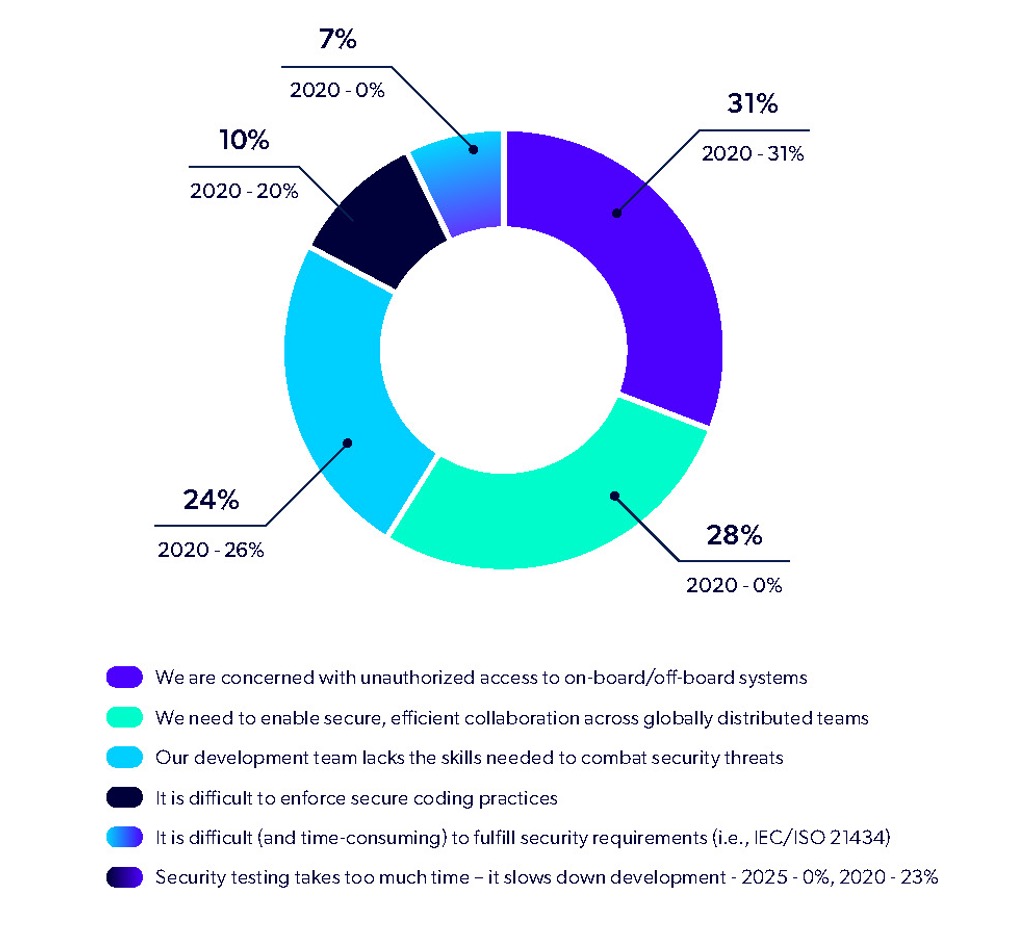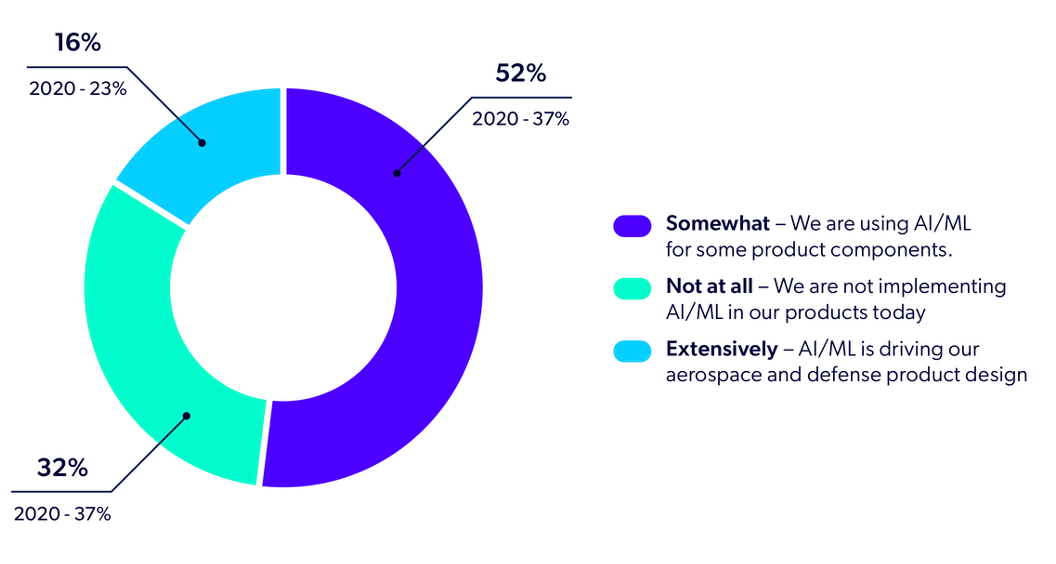Blog
August 27, 2025
Aerospace and Defense Industry Trends: Software Development
Security & Compliance,
DevOps
Find out which aerospace and defense industry trends you need to know. In this blog, we recap key aerospace and defense industry trends — and explore strategies to help you keep up.
Evolution of Aerospace and Defense Industry Trends
The aerospace and defense industries have consistently produced leading designs by using:
- Modern techniques.
- Inventive technologies.
- Innovative manufacturing processes.
Some of these measures have led to disruptions. This is true for the overall aerospace and defense industries. And these trends have an impact on the software development teams as well.
Make sure your software development team can be more prepared to effectively manage them.
Get the Aerospace and Defense Report
In 2025, we surveyed aerospace and defense software developers. Find out what they said about everything from cloud-based technologies to software security. Get the full insights.
Key 2025 Aerospace and Defense Industry Trends
You need to be prepared for the following key aerospace and defense industry trends:
- Autonomous vehicles/robots.
- Sustainability and green aviation.
- Advanced manufacturing.
If you aren't prepared, you could fall behind in development time and software quality.
Here's what you need to know about the top aerospace and defense industry trends.
Autonomous Vehicles/Robots
Autonomous vehicles and robots will become more commonplace within the next several years.
Here's one notable area of design. Autonomous military vehicles are produced for tough environmental conditions as well as on the battlefield. In fact, the Pentagon requested a $13.4 billion investment in AI and autonomy for the 2026 fiscal year. Among small undersea drones, autonomous "wingman" fighter drones alongside jets, and general AI research, Defense One says that this includes a new Air Force budget for a drone swarm program called Offensive Small Unmanned Aircraft Systems.
📕 Related Resource: Keep Unmanned Aerial Vehicle Software Safe and Secure
However, unmanned and autonomous vehicles present a challenge for defense software developers. You need to ensure that the embedded devices installed in these vehicles are adaptive, reliable, and efficient.
What’s more, those embedded devices may provide cybercriminals with an opportunity to hack the vehicle. Using secure coding practices along with a static code analyzer is key.
Space Commercialization and Exploration
The final frontier is becoming more accessible. Private companies like SpaceX and Blue Origin are leading the charge in commercial space exploration, driving down costs with reusable rocket technology. This expansion creates a surge in demand for sophisticated software to manage complex mission, satellite constellations, and orbital logistics.
The U.S. DoD has also included space research in its 2025 budget request, focusing on solid rocket motors ranging from missile technology to requirements in the space arena.
For software developers, this means a greater focus on:
- Mission-critical systems. Developing flawless code for launch control, navigation, and life-support systems where failure is not an option.
- Big data management. Creating solutions to process and analyze the immense volume of data transmitted from satellites and deep-space probes.
- Autonomous operations. Building intelligent systems for robotic missions, resource extraction, and in-orbit manufacturing.
Sustainability and Green Aviation
Environmental responsibility is now a primary driver of innovation in aerospace. The industry is pushing hard to reduce its carbon footprint, with a strong focus on Sustainable Aviation Fuels (SAFs) and the development of electric and hybrid-electric propulsion systems.
According to the International Energy Agency (IEA), airplane emissions are estimated to have exceeded pre-COVID-19-pandemic levels. Recent global regulations and initiatives, such as the 2024 U.S. Aviation Climate Action Plan, are accelerating the transition toward net-zero emissions, with the goal of reducing carbon emissions by 2050.
Software development is central to this green transition. Developing new engines will require sophisticated software and control electrics. These ensure that the machine can successfully achieve the amount of output necessary for lift. Software teams will be tasked with:
- Engine efficiency optimization: Designing advanced software to control next-generation engines, maximizing fuel efficiency and minimizing emissions.
- Flight path optimization: Using AI and ML algorithms to calculate the most fuel-efficient routes based on weather patterns and air traffic.
- Compliance and reporting: Building systems that monitor, track, and report emissions data to meet stringent international standards.
Aerospace and defense developers will need to continue to comply with functional standards as they evolve to keep up with AI and other new technologies. This includes IEC 61508 and DO-178C, as well as their own internal standards.
Supply Chain Resilience and Advanced Manufacturing
The aerospace and defense industry has some of the most complex and globalized supply chains in the world. From advanced materials and precision components to highly specialized electronics, manufacturers must coordinate a vast network of suppliers and logistics providers.
Global supply chain disruptions in recent years have highlighted the critical importance of resilient manufacturing systems. Software plays a vital role in creating adaptive supply chains that can respond effectively to unexpected challenges. Supply chain optimization requires software with robust data integration capabilities while maintaining data quality and security.
New technologies like additive manufacturing methods are transforming manufacturing by helping to produce critical aerospace components such as turbine blades, heat exchanges, and structural elements with reduced weight and improved performance. Software developers are now using and accounting for innovations like digital twins, automated quality control systems and AI defect detection, smart factory integration through IoT networks, and predictive maintenance platforms.
Aerospace and Defense Industry Trends: Key Takeaways
The role of software developers is even more important to keep up with aerospace and defense industry trends. With each new advancement, new challenges are introduced. And your software teams need to be prepared.
In the recorded webinar below, our aerospace software development expert discusses these aerospace and defense industry trends — and what it means for you.
3 Aerospace and Defense Industry Trends: Report Highlights
We surveyed 150 aerospace and defense developers to better understand aerospace and defense industry trends. In particular, we asked about technology trends.
All of the responses were recorded in the 2025 State of Aerospace and Defense Software Development Report. Here are some of the key findings from our report:
Security
Hackers are the largest security concern of the aerospace and defense software developers that we surveyed. And, for good reason too. Over the past several years, the frequency and severity of air transport industry cyberattacks has steadily increased. Outages such as the 2024 CrowdStrike IT outage highlight the vulnerabilities in software updates and supply chains, as well as critical infrastructure.

Source: 2025 Aerospace and Defense Report
Aerospace and defense organizations will share more responsibility for protecting their software, and that starts with following DevSecOps best practices, using static analysis tools that check for vulnerabilities, and achieving compliance with established coding and security standards.
Download the Aerospace and Defense Cybersecurity White Paper
To mitigate increasing risks, development teams must think strategically when it comes to the aerospace and defense cybersecurity of tomorrow. Gain insights into coding guidelines and automated testing tools that help safeguard embedded software against cyber threats.
Cloud-Based Technologies
Design is most impacted by cloud-based technologies. Aerospace and defense manufacturing processes are often time-consuming and complex. Cloud-based technologies can help.
Cloud-based technologies are characterized by their flexibility, efficiency, and functionality. This makes them ideal for teams to quickly test ideas and theories within a secure framework.
In fact, according to Aerospace Testing International, the U.S. Air Force estimates that it shortened the amount of time needed to implement new ideas by 70%. And they reduced the cost of design expenditures by hundreds of millions of dollars annually. This was all done by using cloud-based technologies.
Many of the survey respondents are now extensively working on some Cloud-based technologies; however, many are still concerned about the safety and security of Cloud tech. There is less concern, though, for time-to-market and development costs compared to the 2020 report.
AI and Machine Learning
Both AI and machine learning have the potential to radically change aerospace and defense development. And, a majority of the software developers that we surveyed said that AI/ML was at least somewhat impacting their product design, an increase of 15%.

Source: 2025 Aerospace and Defense Report
What's more, this trend is expected to continue. The Boston Consulting Group reported that in 2024, the aerospace and defense industry spent $26.6 billion USD on AI, which is expected to grow to $44 billion by 2030.
Get the Full Scoop
Get the State of Aerospace and Defense Report. You'll get the full scoop on aerospace and defense industry trends. And you'll find out what you need to do to prepare for the future today.
See how an industry standardized static analysis tool — like Perforce QAC and Perforce Klocwork — can enable your team to verify standards compliance and easily integrate into CI/CD pipelines. Request your free trial today!

